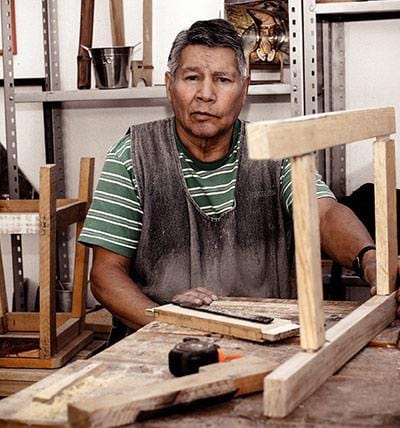Have you ever thought about building your own wooden clock?
Apparently people do it. Absolutely awesome process, very tedious and we got a little article here to show you exactly what this process looks like.
This clock that we're building could be a gift for your daughter and this is something you can pass on to her when she eventually moves on and starts her own life.
The design of this clock is very forgiving and has a great introduction to the art of building wooden clocks, it is on the more simple end of the scale so even beginner clock makers can have a go - not some very complicated like a cuckoo clock!

Each wheel begins as a drawing that gets glued to a piece of plywood using spray adhesive.
All critical components should be made from high quality plywood for the sake of stability.
Stanley is using a Mahogany ply from aircraftspruce.com. To cut the gears, the scroll saw is outfitted with a 12 and a half tooth per inch, 5R blade. For the inside cuts, a simple drilled hole provides a starting point.
After cutting, the teeth can be cleaned up using a sanding strip in the scroll saw.After the wheel has been cut out, the paper is removed using some naphtha. The paper usually peels right off of the wood.
This is the escape wheel, the part of the clock that gives it the ticking sound. It's critical that the tips are crisp and concentric by mounting the wheel on a shaft, the tips can be sanded to perfect concentricity. The cannon pinion receives a through hole and a countersink. To maintain concentricity, the blank is taped to the table surface.
The larger countersink is drilled first and the smaller through hole is drilled second. Some parts will receive a hole between two teeth that holds then tap to create threads for a set screw. All the frame pieces are made out of three quarter inch solid maple. The parts are cut out the same way as the gears using the provided templates. A chisel is used to make a notch for the drive gear. The one shaft support fits into a dado on the front of the main frame.
A dado stack at the table saw removes the material on either side of the shaft and a dial caliper verifies that the support is only a few thousands wider than a notch in the frame. A few passes with some sandpaper should produce a nice snug fit. The drive gear assembly consists of the drive gear, the pulley for the weight chord and the click gear. The parts are glued together using a drill bit to hold the parts in position while the glue dries. The intermediate wheel assembly consists of the intermediate wheel, a spacer and the intermediate pinion.
The third wheel assembly consists of the third wheel, a spacer and a third pinion. The escape wheel assembly consists of the escape wheel, a spacer and the escape pinion. Small breast tubes are then inserted into the assemblies using an arbor press. The frame consists of eight parts. Everything gets glued and clamped together and screws are added through the back side of the rear frame for extra support. That may seem like a lot of clamps but you need to do whatever is necessary to get good glue contact. The rear vertical frame is then glued to the main frame. The brush shafts needs to be polished before they're pressed into the rear vertical frame. Using the drill press and some polishing compound, the shafts take on a nice shine.

The shafts are then pressed into the frame with an arbor press and a dead blow hammer where needed. With the gears in place, it's time for fine tuning. By spinning the gears manually, the floss becomes obvious as the gears simply bind up. A rotary tool is used to relieve some of the material from the pinion teeth and then we can test again. There's only a few teeth that bind up this time so we'll use the rotary tool to relieve the offending material. When the gears turn freely, the fine tuning is done.
You can even blow on the gears and they should turn freely. The Pendulum Bob is made from three pieces of walnut. The inner piece is cut to rough shape and then glued to a backer. This creates two pockets where led shot can be added for extra weight. A precut piece of walnut seals the deal. Once the glue is dry, the Bob is cut to its final shape. A two pound cut of shellac is applied to the face of the gears, taking care to get no finish on the gear teeth. A total of three coats is applied. With the clock dry assembled, a four pound weight is added to test the clock's movement. The wood clock will likely stop now and then as it breaks in but the weight can be adjusted for optimal performance. The clock hands are made from Purpleheart and Canarywood. After rough cutting, the parts are glued together and then shaped at the disk sander. The center is then cut out of the scroll saw for a decorative effect and a rotary tool is used to further shape each hand.
The clock face is then cut from a sandwich of maple and walnut. The clock weight will be made from a steel tube capped off with walnut. The tube will be filled with led shot, bring you this close to four pounds as possible. The remaining clock parts we finished with General Finishes Enduro-Var, a high quality water based finish. (Underwood) Now it's time to hang the clock. The clock's been running pretty steady now for about three weeks. We had to make just a few minor adjustments to the pendulum but its finally found its home and this is now the second wind that we've been on that the time has been just perfect. It will ran about 26, 27 hours or so on a wind. Every morning we get up, we wind the clock, yeah. That's it. Thanks a lot for coming on this journey with us and we hope it's inspired you to try and make your own clock. It is a very easy thing to do. You really don't need a lot of tools. All you need is a lot of patience.
ABOUT THE AUTHOR
Olivia Poglianich
Content Strategist
Olivia Poglianich is a nomadic brand strategist and copywriter in the wooden crafts and 3D product design space who has worked with brands such as Visa, Disney and Grey Goose. Her writing has taken her all over the world, from a Serbian music festival to a Malaysian art and culture event. Olivia is a graduate of Cornell University and is often writing or reading about travel, hospitality, the start-up ecosystem or career coaching. Her latest interests are at the intersection of web3 and communal living, both on and offline.






